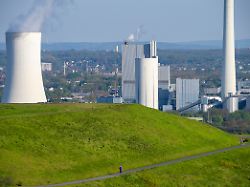Energy company is for sale
Steag praises its advantages – gas power plants possible
06/11/2023, 11:00 a.m
The energy supplier Steag is looking for a new owner and wants the deal to be dry and dry by the summer. Before that, the CEO once again praises the advantages of the location: new power plants could be built everywhere. In addition, the charcoal piles brought back to the grid would still be needed for months.
The energy company Steag, which is up for sale, sees itself well positioned for the energy transition for the construction of controllable gas power plants at its six power plant locations. “We can build such power plants,” said the CEO, Andreas Reichel. In principle, all six locations in the Ruhr area and in Saarland could be considered – also with regard to the construction of electrolysers and battery storage systems. Such power plant projects can be implemented quickly at two or three locations.
As an example, Reichel cited the coal-fired power plant in Duisburg-Walsum, which could be converted into a biomass or gas plant, the Bergkamen site on the eastern edge of the Ruhr area, or the Saarland site in Quierschied, which already has approval for a gas pipeline. Such flexibly controllable gas-fired power plants are intended to cover the demand for electricity when the generation of wind and sun is not sufficient. In order to reduce greenhouse gas emissions, they should be able to be operated 100 percent with hydrogen in the future.
The federal government intends to develop a strategy for such flexibly controllable power plant capacities by the summer. It will “comprise instruments that should lead to investments in new buildings and modernization of 25 gigawatts of controllable capacities in the short to medium term,” said a spokeswoman for the Ministry of Economic Affairs. They are currently also in talks with the EU Commission, “since early coordination has greater chances of rapid implementation”. The completion of the strategy is also affected by this, among other things. The ministry is sticking to the schedule without giving any further details.
money for maintenance
“If we want to have gas-fired power plants by 2030, then the conditions for this must be in place by the end of this year,” said Reichel. The rule of thumb “one, two, three” applies to the realization of such systems: one year for planning, two years for approval and three years for construction. He therefore assumes that the federal government will soon present its strategy.
In this context, Reichel spoke out in favor of creating a capacity market in which power plant operators receive money for making electricity generation capacity available – even when the power plants are not running. “How do you do something like that? By using auctions, for example, to determine who can guarantee a guaranteed service at the lowest price in a specific time window.” In Belgium, for example, this is done for periods of up to 15 years. Reichel assumes that no company will invest in the new gas-fired power plants needed for the energy transition if only the electricity generated is paid for.
Steag: Demand for electricity will increase in winter
At the height of the gas crisis last year, the federal government made it possible, among other things, to reactivate hard coal-fired power plants that were or were about to be shut down, so that less natural gas was used to generate electricity. They can produce and sell electricity until the end of March 2024. Steag has brought power plants with an output of almost 2.5 gigawatts onto the market. “We assume that we will have these power plants on the market by spring 2024,” said Reichel. At the moment they are mostly not in operation because of the low wholesale prices. “But last winter they did an important job in terms of security of supply.” Reichel assumes that electricity demand and prices will rise again next winter. “And so we assume that the power plants will continue to be needed.”
The Essen group belongs to a consortium of six municipal utilities from the Ruhr area. In 2021 they decided to sell the company, which was then under great economic pressure. Since the beginning of the year, it has been divided into a black area (electricity generation from hard coal, “Steag Power”) and a green area (regenerative growth business, “Iqony”). But it will be sold as a whole. “I’m assuming that we’ll sign a contract to sell Steag to a new owner in the summer,” said Reichel.
